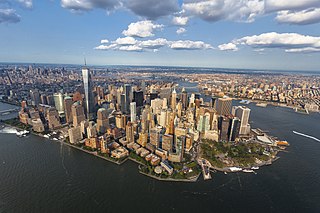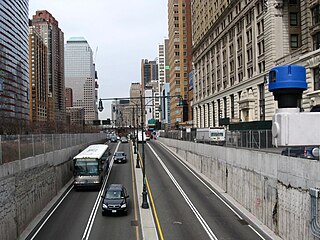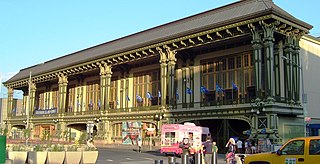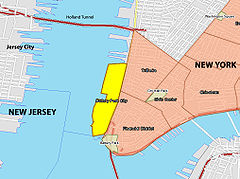
Battery Park City is a mainly residential 92-acre (37 ha) planned community and neighborhood on the west side of the southern tip of the island of Manhattan in New York City. It is bounded by the Hudson River on the west, the Hudson River shoreline on the north and south, and the West Side Highway on the east. The neighborhood is named for the Battery, formerly known as Battery Park, located directly to the south.

North River is an alternative name for the southernmost portion of the Hudson River in the vicinity of New York City and northeastern New Jersey in the United States.

Lower Manhattan, also known as Downtown Manhattan or Downtown New York, is the southernmost part of Manhattan, the central borough for business and culture. The neighborhood is the historical birthplace and serves as the seat of government of New York City. Because there are no municipally defined boundaries for the neighborhood, a precise population cannot be quoted, but several sources have suggested that it was one of the fastest-growing locations in New York City between 2010 and 2020, related to the influx of young adults and significant development of new housing units.
The Brooklyn–Battery Tunnel, officially the Hugh L. Carey Tunnel and commonly referred to as the Battery Tunnel or Battery Park Tunnel, is a tolled tunnel in New York City that connects Red Hook in Brooklyn with the Battery in Manhattan. The tunnel consists of twin tubes that each carry two traffic lanes under the mouth of the East River. Although it passes just offshore of Governors Island, the tunnel does not provide vehicular access to the island. With a length of 9,117 feet (2,779 m), it is the longest continuous underwater vehicular tunnel in North America.

The Joe DiMaggio Highway, commonly called the West Side Highway and formerly the Miller Highway, is a 5.42-mile-long (8.72 km) mostly surface section of New York State Route 9A (NY 9A), running from West 72nd Street along the Hudson River to the southern tip of Manhattan in New York City. It replaced the West Side Elevated Highway, built between 1929 and 1951, which was shut down in 1973 due to neglect and lack of maintenance, and was dismantled by 1989. North of 72nd Street the roadway continues north as the Henry Hudson Parkway.

U Thant Island is a small artificial island or islet in the borough of Manhattan in New York City. The 100-by-200-foot island, created during the construction of the Steinway Tunnel directly underneath, is the smallest island in Manhattan.

Pearl Street is a street in the Financial District in Lower Manhattan, running northeast from Battery Park to the Brooklyn Bridge with an interruption at Fulton Street, where Pearl Street's alignment west of Fulton Street shifts one block south of its alignment east of Fulton Street, then turning west and terminating at Centre Street.

17 State Street is a 42-story office building along State Street and Battery Park in the Financial District of Lower Manhattan in New York City. Completed in 1988, it was designed by Roy Gee for Emery Roth and Sons for developers William Kaufman Organization and JMB Realty. The building is shaped like a quarter round, with a curved glass facade facing New York Harbor. At ground level, large aluminum columns surround a lobby and elevator hall. Next to the lobby was a public exhibition space called "New York Unearthed", which was operated by the South Street Seaport Museum from 1990 to 2005. The building has a total floor area of 525,000 sq ft (48,800 m2); each story was designed for small tenants.

The Battery Park Underpass is a vehicular tunnel at the southernmost tip of Manhattan, New York City, near the neighborhoods of South Ferry and Battery Park City. The tunnel connects FDR Drive, which runs along the east side of Manhattan Island, with the West Side Highway, which runs along the island's west side. Opened in 1951, it was the second section of the FDR Drive to be completed. The underpass crosses beneath the Battery and the approach to the Brooklyn–Battery Tunnel.

South Street is a street in Lower Manhattan, New York City, located immediately adjacent to the East River. It runs from Whitehall Street near the southern tip of Manhattan to Jackson Street near the Williamsburg Bridge. The Franklin D. Roosevelt East River Drive, in an elevated portion known as the South Street Viaduct, runs along the entire length of the street.
Beekman Place is a small street located in the Turtle Bay neighborhood on the East Side of Manhattan, New York City. Running from north to south for two blocks, the street is situated between the eastern end of 51st Street and Mitchell Place, where it ends at a retaining wall above 49th Street, overlooking the glass apartment towers at 860 and 870 United Nations Plaza, just north of the headquarters of the United Nations. "Beekman Place" also refers to the small residential enclave that surrounds the street itself. It is named after the Beekman family, who were influential in New York City's development.

The Manhattan Waterfront Greenway is a waterfront greenway for walking or cycling, 32 miles (51 km) long, around the island of Manhattan, in New York City. The largest portions are operated by the New York City Department of Parks and Recreation. It is separated from motor traffic, and many sections also separate pedestrians from cyclists. There are three principal parts — the East, Harlem and Hudson River Greenways.

Pier A, also known as City Pier A, is a pier in the Hudson River at Battery Park in Lower Manhattan, New York City. It was built from 1884 to 1886 as the headquarters of the New York City Board of Dock Commissioners and the New York City Police Department (NYPD)'s Harbor Department. Pier A, the only remaining masonry pier in New York City, contains a two- and three-story structure with a clock tower facing the Hudson River. The pier is a New York City designated landmark and is listed on the National Register of Historic Places (NRHP).

The Battery Maritime Building is a building at South Ferry on the southern tip of Manhattan Island in New York City. Located at 10 South Street, near the intersection with Whitehall Street, it contains an operational ferry terminal at ground level, as well as a hotel and event space on the upper stories. The ground story contains three ferry slips that are used for excursion trips and ferries to Governors Island, as well as commuter trips to Port Liberté, Jersey City. The upper stories contain the Cipriani South Street event space, operated by Cipriani S.A., and a 47-room hotel called Casa Cipriani.

The Whitehall Building is a three-section residential and office building near the southern tip of Manhattan Island in New York City, adjacent to Battery Park in lower Manhattan. The original 20-story structure on Battery Place, between West Street and Washington Street, was designed by Henry Janeway Hardenbergh, while the 31-story Whitehall Building Annex on West Street was designed by Clinton and Russell. The original building and annex are both at 17 Battery Place. Another 22-story addition at 2 Washington Street, an International Style building located north of the original building and east of the annex, was designed by Morris Lapidus.

The Whitehall Terminal is a ferry terminal in the South Ferry section of Lower Manhattan, New York City, at the corner of South Street and Whitehall Street. It is used by the Staten Island Ferry, which connects the island boroughs of Manhattan and Staten Island. The Whitehall Terminal is one of the ferry's two terminals, the other being St. George Terminal on Staten Island.

The East River Greenway is an approximately 9.44-mile-long (15.19 km) foreshoreway for walking or cycling on the east side of the island of Manhattan on the East River. It is part of the Manhattan Waterfront Greenway. The largest portions are operated by the New York City Department of Parks and Recreation. It is separated from motor traffic, and many sections also separate pedestrians from cyclists. The greenway is parallel to the Franklin D. Roosevelt East River Drive for a majority of its length.

The Battery, formerly known as Battery Park, is a 25-acre (10 ha) public park located at the southern tip of Manhattan Island in New York City facing New York Harbor. It is bounded by Battery Place on the north, with Bowling Green to the northeast, State Street on the east, New York Harbor to the south, and the Hudson River to the west. The park contains attractions such as an early 19th-century fort named Castle Clinton; multiple monuments; and the SeaGlass Carousel. The surrounding area, known as South Ferry, contains multiple ferry terminals, including the Staten Island Ferry's Whitehall Terminal; a boat launch to the Statue of Liberty National Monument ; and a boat launch to Governors Island.

Elizabeth H. Berger Plaza is a public park in the Financial District of Manhattan, New York City. formed by the triangular junction of Trinity Place, Greenwich Street and Edgar Street. It faces the Manhattan exit ramp from the Brooklyn–Battery Tunnel. Formerly known as the Edgar Street Greenstreet, this park honors civic advocate Elizabeth H. Berger (1960-2013). In her role as president of the Downtown Alliance, she advocated for the fusion of two traffic triangles at this location into an expanded park. The park is located on the site of a former neighborhood known as Little Syria, a bustling immigrant community displaced by the construction of the tunnel in 1953.

Lower Manhattan Coastal Resiliency (LMCR) refers to a range of climate change adaptation strategies of coastal management to address impacts on the city in the wake of the extensive Hurricane Sandy flooding of 2012.
























